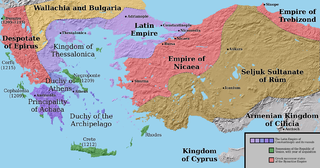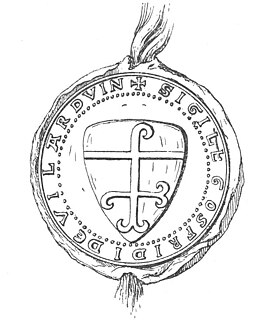Related Research Articles

The Principality of Achaea or Principality of Morea was one of the three vassal states of the Latin Empire, which replaced the Byzantine Empire after the capture of Constantinople during the Fourth Crusade. It became a vassal of the Kingdom of Thessalonica, along with the Duchy of Athens, until Thessalonica was captured by Theodore, the despot of Epirus, in 1224. After this, Achaea became for a while the dominant power in Greece.

The Duchy of the Archipelago, also known as Duchy of Naxos or Duchy of the Aegean, was a maritime state created by Venetian interests in the Cyclades archipelago in the Aegean Sea, in the aftermath of the Fourth Crusade, centered on the islands of Naxos and Paros. It included all the Cyclades. In 1537 it became a tributary of the Ottoman Empire, and was annexed by the Ottomans in 1579; however, Christian rule survived in islands such as Siphnos and Tinos.

William of Villehardouin was the fourth prince of Achaea in Frankish Greece from 1246 to 1278. The younger son of Prince Geoffrey I, he held the Barony of Kalamata in fief during the reign of his elder brother Geoffrey II. William ruled Achaea as regent for his brother during Geoffrey's military campaigns against the Greeks of Nicaea, who were the principal enemies of his overlord, the Latin Emperor of Constantinople Baldwin II. William succeeded his childless brother in the summer of 1246. Conflicts between Nicaea and Epirus enabled him to complete the conquest of the Morea in about three years. He captured Monemvasia and built three new fortresses, forcing two previously autonomous tribes, the Tzakones and Melingoi into submission. He participated in the unsuccessful Egyptian crusade of Louis IX of France, who rewarded him with the right to issue currency in the style of French royal coins.

William I of Champlitte (1160s-1209) was a French knight who joined the Fourth Crusade and became the first prince of Achaea (1205–1209).

Geoffrey I of Villehardouin was a French knight from the County of Champagne who joined the Fourth Crusade. He participated in the conquest of the Peloponnese and became the second prince of Achaea.

Geoffrey II of Villehardouin was the third prince of Achaea. From his accession to the princely throne, he was a powerful and respected person, and even French knights came to the principality to enter his service. Geoffrey II emerged as the most powerful vassal of the Latin Empire of Constantinople, the person around whom the crusaders' states in modern Greece gradually regrouped themselves. He came to the rescue of the imperial capital three times. As a reward of his services to the Latin Empire, he was granted suzerainty over the island of Euboea by his brother-in-law, Emperor Baldwin II of Constantinople (1228–1261). He was also a humane prince, benevolent and just, solicitous for the condition of the common people.

Othon de la Roche, also Otho de la Roche, was a Burgundian nobleman of the De la Roche family from La Roche-sur-l'Ognon. He joined the Fourth Crusade and became the first Frankish Lord of Athens in 1204. In addition to Athens, he acquired Thebes by around 1211.
William I de la Roche succeeded his brother, John I, as Duke of Athens in 1280.

The Frankokratia, also known as Latinokratia and, for the Venetian domains, Venetokratia or Enetokratia, was the period in Greek history after the Fourth Crusade (1204), when a number of primarily French and Italian states were established by the Partitio terrarum imperii Romaniae on the territory of the dissolved Byzantine Empire.
Kenneth Meyer Setton was an American historian and an expert on the history of medieval Europe, particularly the Crusades.
Otho of Saint Omer was the lord of half of Thebes in Frankish Greece from 1294 to ca. 1299.

John of Saint Omer was baron of a third of Akova and marshal of the Principality of Achaea.
Guy of Charpigny was the second Baron of Vostitsa in the Principality of Achaea in Frankish Greece.

Richard Orsini was the Count Palatine of Cephalonia and Zakynthos from before 1260 to his death in 1303/4, and also Captain-General of Corfu in 1286–90, Count of Gravina in 1284–91. He also served as the Angevin bailli in the Principality of Achaea from 1297 to 1300.
Geoffrey of Briel, in older literature Geoffrey of Bruyères, was a French knight and the third lord of the Barony of Karytaina in the Principality of Achaea, in Frankish Greece. He led a colourful and turbulent life, narrated in detail in the Chronicle of the Morea. Accounted the finest knight in the Principality, he fought in the wars against the Byzantine Greeks, was captured in the Battle of Pelagonia in 1259, and was sent back to Achaea bearing the Byzantine terms in 1261. Geoffrey was twice deprived of his barony, once for rebelling against his uncle, the Prince of Achaea William II of Villehardouin, and then for abandoning the Principality without leave in order to spend time with a mistress, the wife of one of his feudatories, in Italy. He was pardoned both times, but henceforth held his title as a gift of the Prince. He died childless in 1275, and the Barony of Karytaina was split up.
Philip, of the Capetian House of Anjou, was the second son of King Charles I of Sicily and Countess Beatrice of Provence. He was at various times set up to become King of Sardinia, Prince of Achaea or King of Thessalonica, but ultimately ascended no throne.
The First Parliament of Ravennika was convened in May 1209 by Latin Emperor Henry of Flanders in the town of Ravennika in Central Greece in an attempt to resolve the rebellion of the Lombard barons of the Kingdom of Thessalonica.
The Second Parliament of Ravennika was convened in May 1210 by Latin Emperor Henry of Flanders in the town of Ravennika in Central Greece in order to resolve the differences between the princes of Frankish Greece and the Roman Catholic clergy of their domains.
William I of Verona was the ruler of the central terziere, or third, of the Lordship of Negroponte in Frankish Greece from 1216 to 1263. He was also the titular of king of Thessalonica from 1243 to 1246.
The bailli, bailie, or bailiff was the administrative representative of the Princes of Achaea, ruling the Principality of Achaea in the Prince's absence. The early princes, who belonged to the founding Villehardouin dynasty, resided in the principality, and governed it directly. In 1278, Achaea passed to Charles of Anjou, the King of Naples. Charles, and many of his successors, ruled the principality through their baillis, and never visited it in person. Originally, the baillis were Angevin officials, but the post was often given to powerful feudatories from Achaea and the rest of Frankish Greece.
References
- ↑ Longnon 1969, p. 245.
- ↑ Setton 1991, p. 78.